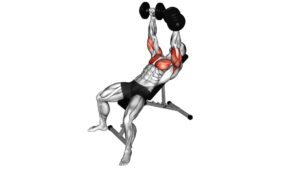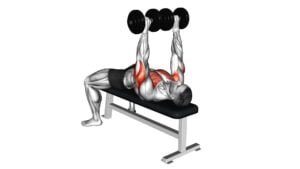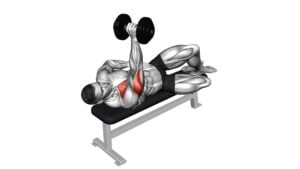Dumbbell Bench Press – Video Exercise Guide & Tips

Get ready to pump up your chest with the dumbbell bench press! In this video exercise guide, we'll show you the proper form and technique for maximum gains.
Watch This Exercise Video
Whether you're a beginner or advanced lifter, we've got variations and progressions to challenge your muscles. Avoid common mistakes and get tips for a killer chest workout.
Grab those dumbbells and let's get started!
Key Takeaways
- Engages multiple muscle groups simultaneously
- Provides greater range of motion compared to barbell bench press
- Targets chest, shoulders, and triceps
- Allows for a neutral grip, which is more comfortable for individuals with shoulder issues
Benefits of Dumbbell Bench Press
One of the benefits of performing the Dumbbell Bench Press is that it allows you to engage multiple muscle groups simultaneously. This exercise is a compound movement that targets your chest, shoulders, and triceps. By using dumbbells instead of a barbell, you also activate your stabilizer muscles, which help improve overall strength and muscle balance.
One advantage of the Dumbbell Bench Press is that it allows for a greater range of motion compared to the barbell bench press. This increased range of motion helps to engage more muscle fibers in your chest, resulting in greater muscle activation and growth. Additionally, the dumbbells allow you to perform the exercise with a neutral grip, which can be more comfortable for individuals with shoulder issues.
Another advantage of this exercise is that it requires each side of your body to work independently. This helps to address any muscle imbalances or weaknesses that may exist between your left and right sides. By working each side separately, you can ensure that both sides are equally strong and reduce the risk of injury.
Proper Form and Technique
To ensure proper form and technique during the Dumbbell Bench Press, use a firm and stable bench. This is essential for stability and safety. Avoid using a wobbly or uneven surface, as it can throw off your balance and increase the risk of injury.
When performing the exercise, make sure your back is flat against the bench, and your feet are firmly planted on the ground. This will provide a solid foundation for the movement. Another common mistake to avoid is arching your back excessively. While a slight arch is natural, too much can strain your lower back and lead to discomfort or injury. Keep your core engaged throughout the exercise to maintain proper alignment.
Additionally, be mindful of your grip. Hold the dumbbells with a neutral grip (palms facing each other) to reduce strain on your wrists and forearms. By following these tips and avoiding these common errors, you can maximize the effectiveness of the Dumbbell Bench Press while minimizing the risk of injury.
Variations and Progressions
Try incorporating different variations of the dumbbell bench press to challenge your muscles and continue making progress in your workouts.
Once you have mastered the basic form and technique, you can move on to more advanced techniques to further enhance your strength and muscle development.
One advanced technique is the incline dumbbell bench press, which targets the upper chest muscles more effectively. By adjusting the bench to a 30-45 degree angle, you can place more emphasis on the clavicular head of the pectoralis major.
Another variation is the decline dumbbell bench press, where the bench is set at a downward angle. This targets the lower chest muscles and can help to develop a more well-rounded chest.
Additionally, you can try performing the dumbbell bench press on an unstable surface, such as a stability ball, to engage your core muscles and improve stability.
If you're looking for alternative exercises to the dumbbell bench press, you can try the barbell bench press or the push-up. Both exercises work similar muscle groups and can provide a different challenge for your workouts.
Remember to gradually increase the weight and difficulty of the variations and progressions to continue challenging your muscles and making progress in your fitness journey.
Common Mistakes to Avoid
When performing the dumbbell bench press, it's important to avoid common mistakes that can hinder your progress and potentially lead to injury. By preventing injuries and maximizing gains, you can ensure that you're getting the most out of this exercise.
One common mistake to avoid is using too much weight. It can be tempting to go heavy, but using weights that are too heavy can compromise your form and increase the risk of injury.
Another mistake isn't maintaining proper form throughout the exercise. It's important to keep your back flat on the bench, your feet planted on the ground, and your elbows at a 90-degree angle. Avoid dropping the weights too quickly or letting them touch your chest. This can strain your shoulders and decrease the effectiveness of the exercise.
Finally, make sure to warm up before starting the dumbbell bench press. This will help prepare your muscles and joints for the exercise, reducing the risk of injury.
Tips for a Killer Chest Workout
To maximize the effectiveness of your dumbbell bench press and achieve a killer chest workout, focus on incorporating a variety of exercises that target different areas of your chest. Building chest muscles requires a combination of compound and isolation exercises.
Start with the dumbbell bench press, which targets your overall chest. Then, incorporate exercises like dumbbell flyes to specifically isolate your pectoral muscles. To further engage your chest, include exercises like push-ups and dips, which activate your chest muscles along with other upper body muscles.
In addition to incorporating a variety of exercises, it's essential to pay attention to your breathing techniques. Proper breathing can enhance the effectiveness of your chest workout. When performing the dumbbell bench press or any other chest exercise, inhale as you lower the weights and exhale as you push them up. This controlled breathing helps stabilize your core and engages your chest muscles more effectively.
Frequently Asked Questions
How Much Weight Should I Start With When Performing the Dumbbell Bench Press?
When starting the dumbbell bench press, it's important to choose a weight that challenges you but doesn't compromise form. Begin with a weight that you can comfortably lift for 8-10 reps with proper technique.
As you progress, gradually increase the weight to continue challenging your muscles. The key is to find a progression rate that allows you to gradually increase the weight while maintaining good form and avoiding injury.
Can I Perform the Dumbbell Bench Press if I Have Shoulder Pain or Injuries?
If you have shoulder pain or injuries, it's important to be cautious when performing the dumbbell bench press. You may want to consider modifications or alternatives to this exercise.
Consult with a healthcare professional or a certified trainer who can help you find exercises that are safe and effective for your specific condition. It's crucial to prioritize your health and avoid further aggravating any existing injuries.
Is It Necessary to Have a Spotter While Performing the Dumbbell Bench Press?
Having a spotter while performing the dumbbell bench press is beneficial for safety and assistance. They can help you maintain proper form, prevent injury, and provide support when you need it.
However, if you don't have a spotter, there are alternatives to the dumbbell bench press that can still develop your chest muscles effectively. It's important to choose exercises that align with your fitness goals and abilities.
How Often Should I Incorporate the Dumbbell Bench Press Into My Workout Routine?
To incorporate the dumbbell bench press into your workout routine effectively, it's important to consider frequency.
Without the context of specific guidelines, it's recommended to include this exercise 2-3 times per week. This allows for adequate muscle stimulation and recovery.
However, it's essential to listen to your body and adjust accordingly. Remember to start with lighter weights and gradually increase as you become more comfortable and confident with the movement.
Are There Any Specific Warm-Up Exercises That I Should Do Before Performing the Dumbbell Bench Press?
Before performing the dumbbell bench press, it's important to do specific warm-up exercises to prepare your body. These warm-up exercises will help increase your shoulder mobility and prevent injury.
By incorporating exercises like shoulder rolls, arm circles, and band pull-aparts into your warm-up routine, you can improve your range of motion and activate the muscles needed for the dumbbell bench press.
Remember to always prioritize a proper warm-up before any exercise to ensure a safe and effective workout.
Conclusion
The dumbbell bench press is a highly effective exercise for building a strong and powerful chest. By using dumbbells instead of a barbell, you can engage the muscles in your chest more effectively and target any imbalances.
Proper form and technique are crucial to maximize the benefits of this exercise and prevent injuries. With variations and progressions, you can continuously challenge your muscles and keep progressing.
Avoid common mistakes and follow these tips for a killer chest workout.

Author
Years ago, the spark of my life’s passion ignited in my mind the moment I stepped into the local gym for the first time. The inaugural bead of perspiration, the initial endeavor, the very first surge of endorphins, and a sense of pride that washed over me post-workout marked the beginning of my deep-seated interest in strength sports, fitness, and sports nutrition. This very curiosity blossomed rapidly into a profound fascination, propelling me to earn a Master’s degree in Physical Education from the Academy of Physical Education in Krakow, followed by a Sports Manager diploma from the Jagiellonian University. My journey of growth led me to gain more specialized qualifications, such as being a certified personal trainer with a focus on sports dietetics, a lifeguard, and an instructor for wellness and corrective gymnastics. Theoretical knowledge paired seamlessly with practical experience, reinforcing my belief that the transformation of individuals under my guidance was also a reflection of my personal growth. This belief holds true even today. Each day, I strive to push the boundaries and explore new realms. These realms gently elevate me to greater heights. The unique combination of passion for my field and the continuous quest for growth fuels my drive to break new ground.







